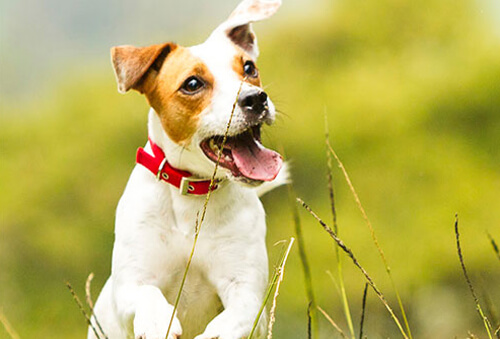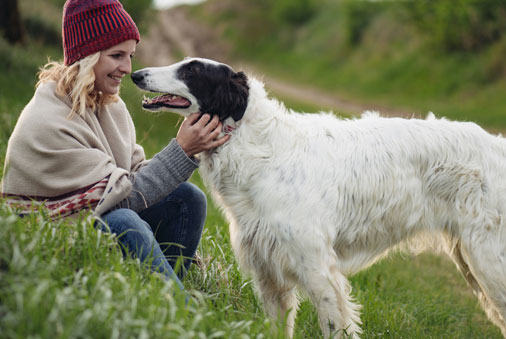Size-Related Health Issues
Collapsed trachea often caused by the pressure that occurs when they jump while their collar is attached to a leash. Prevention tip: Use a harness instead of a collar
Kneecap (patella) injuries from jumping too high. Prevention tip: Use ramps to help small dogs navigate higher surfaces like furniture and steps.
Hypoglycemia, a rapid drop in blood sugar, strikes smaller dogs more than larger ones, especially small breed pups.
Large breed dogs are at a higher risk for:
Hip dysplasia, where the hip joints don’t fit correctly, plagues bigger dogs more than small.
Ligament tears. When a heavier-bodied large dog lands from a jump or makes a sharp turn, it can can twist their legs and tear their ligaments.
Arthritis tends to affect large dogs more because they’re more susceptible to hip and elbow dysplasia than smaller dogs.
Bloat. Deep-chested, large breed dogs can suffer from gastric bloat that may include torsion where the stomach twists and flips over on itself.
Hypothyroidism can affect all dogs,but is most commonly seen in larger breeds.
“Wobblers, ” or Spondylolisthesis is a hereditary malformation of neck vertebrae that can cause weakness and unsteady gait in some large dogs.
We all may be big dog lovers, but some of us literally love large dogs more than little ones, and vice versa. Whether our best pals are little cuties or gentle giants, there are pros and cons to parenting both.
First, let’s get the stereotypes out of the way:
Size myths
Starting with the obvious differences (picture a Great Dane beside a Chihuahua) size definitely plays a role in behavior, training, activity, and lifestyle issues. There are some stereotypical “myths” that shadow breed sizes, however.
• Large = lovable. Big dogs are lovable bears; small dogs are snobbish. Not so fast, plenty of pet parents will tell you their lap dog is affectionate, cuddly and friendly too.
• Small = big bark. The good ol’ Napoleon syndrome: making up for their small size by overcompensating with their barks. Who can blame them for trying to make their small bark heard in a big world? However, all canines bark to communicate. While some smaller dogs are hyperactive and yip and yap a lot, small breeds don’t generally bark any louder or more frequently than other breeds.
• Small dogs don’t need exercise. All dogs require a daily walk, no matter what size they are. Plus all breeds love playing outdoors. A brisk 30- to 45-minute daily walk is a must for optimal health. Small breeds that can have breathing problems like Pugs or French Bulldogs should be walked more slowly but they still need exercise.
Breed size is just one factor that helps shape your best pal’s temperament. How we treat and train our furry friends prominently affects their personalities. Big or small, it all comes down to teaching your pooch that you’re in charge. Quick tip: Start by always entering and exiting the house before your dog.
Why small dogs rule:
More popular. According to the American Kennel Club, small breeds are more popular than large breeds because most of the breeds registered each year are small breeds.
They can cost less. Caring for small dogs generally costs less as far as food and some veterinary costs go. Small breeds eat less and are easier to handle when it comes to spaying, neutering and some surgeries.
Cheap travel dates. It’s easier and less costly to travel with small breeds because they take up less space, especially on airplanes. Extra stars to the little guys for being flight-friendly and more accepted at hotels, stores, and even some restaurants due to their diminutive stature. After all, when was the last time you tried squeezing an Irish Wolf Hound into a pet carrier?
Small dogs make great couch potatoes — er, lap dogs. One good daily stride usually suffices so if your walk time is limited, smaller dogs may be best for your lifestyle.
Ideal city dwellers. Smaller size means better fit for urban life where apartment size is often limited.
The cons of raising a small dog:
Bully targets. Unfortunately, little dogs may be at risk for injury by bigger dogs. Prevention tip: Keep your small dog leashed when walking outside and supervise all playtime within a fenced-in area.
Trouble chillin’. Small breeds’ higher energy levels may make them more wired and cause them to bark more at night. Proper training during their puppy years can help remedy this.
Mind of their own. Small dogs can be more difficult to train than large dogs. They tend to be more territorial indoors than larger dogs who often view the great outdoors as their main turf. However, some small breeds can be litter-box trained, so score one for their size!
Always underfoot. Sadly, their smallness may be hazardous to their health, especially around children. It’s far too easy not to see them curled up between sofa cushions and other hideaways where they may be bumped accidentally. Quick tip: Teach young children how to gently handle small dogs.
Can be aggressive. Smaller dogs can be more aggressive when it comes to seeking attention, begging for food or urinating to mark their territory. This may be due to “babying” them, because of their small stature.
Why large breeds rule:
More of them to love (and adopt). There are often more large breed puppies available to adopt than small pups. This may be due to the fact that little dogs have smaller litters than larger breeds. Also, the smaller the dog is, the more likely they’ll deliver via Caesarean section, which also comes with a higher breeding price tag.
Good watchdogs. Large breed dogs make good guard dogs, if only due to their intimidating size. Hey, would you mess with a Mastiff or Leonberger?
Good with kids. Big breeds are often laid back and more accepting of children than smaller dogs.
Great endurance. Love to walk? Then large dogs are the pals for you. Getting plenty of outdoor time and exercise makes them happy-go-lucky companions who are able to get along with everyone.
Easier to train. Whether it’s their good nature and eagerness to please, many large breed dogs catch on to training better than smaller breeds.
Large breed disadvantages:
Cost more. Bigger size means they eat more food, and they cost more at the veterinarian’s, again because of extra time needed to handle them, sedate them, etc.
Tend to shed more than small dogs. Due to their larger size, which can create problems inside the house where they take up more space.
Not travel- or store-friendly. It costs more to travel with large breeds and many hotels and retail stores don’t allow dogs that weigh over 25 pounds.
Scare people. For the same reason they make good watchdogs, large breeds can also keep people at bay, sending the signal that they’re not the big, lovable pals they tend to be.
Diet. Because smaller dogs have more energy than larger breeds, they need extra calories to meet those needs. Large dogs may wolf down more food but they have different nutritional requirements, including ingredients that support joint health and overall movement. Blue Buffalo® has nutritious foods for any size dog. Learn more about their large breed and small breed formulations.
Lots of heart. Although small dogs’ hearts beat from 100 to 140 times per minute versus large breeds, whose resting heart rate is between 60 and 100, all furry family members have big hearts when it comes to the love and loyalty they give us. Whatever size dog you choose, be sure it’s the right fit for your personality and family’s lifestyle so all of you can enjoy a great life together.





